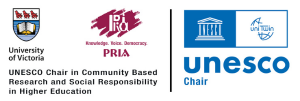Budd L Hall, Co-Chair UNESCO Chair in Community Based Research and Social Responsibility in Higher Education
 The fog bank of social innovation has been moving inalterably from the oceans of social thought towards the shores of community organisations, local governments, and now to institutions of higher education. My concern is that both the discourse and the practice of social innovation seem to have found a breeze that carries them into our organisational lives in a largely unexamined and uncritical manner. I mean it all sounds so wonderful. The Stanford Center for Social Innovation defines social innovation as “a novel solution to a social problem that is more effective, efficient, sustainable, or just than present solutions and for which the value created accrues primarily to society as a whole rather than private individuals.” (csi.gsb.stanford.edu). What could be more desirable? Surely we all want a more just and sustainable society. But can a concept and a practice that does not deal with power imbalances, the usefulness of organizing and political action, or the dominance of colonized knowledge systems really bring about world that is more just and sustainable? What value can the theory and practice of social innovation bring to the world of higher education? Seelos and Mair in their Stanford Social Innovation Review article, “Innovation is Not the Holy Grail” note that the, “social sector has generated a bewildering and confusing set of descriptions of what innovation is and how to achieve it” (2012: 9)
The fog bank of social innovation has been moving inalterably from the oceans of social thought towards the shores of community organisations, local governments, and now to institutions of higher education. My concern is that both the discourse and the practice of social innovation seem to have found a breeze that carries them into our organisational lives in a largely unexamined and uncritical manner. I mean it all sounds so wonderful. The Stanford Center for Social Innovation defines social innovation as “a novel solution to a social problem that is more effective, efficient, sustainable, or just than present solutions and for which the value created accrues primarily to society as a whole rather than private individuals.” (csi.gsb.stanford.edu). What could be more desirable? Surely we all want a more just and sustainable society. But can a concept and a practice that does not deal with power imbalances, the usefulness of organizing and political action, or the dominance of colonized knowledge systems really bring about world that is more just and sustainable? What value can the theory and practice of social innovation bring to the world of higher education? Seelos and Mair in their Stanford Social Innovation Review article, “Innovation is Not the Holy Grail” note that the, “social sector has generated a bewildering and confusing set of descriptions of what innovation is and how to achieve it” (2012: 9)
Remko Berkhout has raised a number of concerns in his blog, “Irresistibly biased? The blind spots of social innovation” (2014:2). In the aftermath of a conference on social innovation, the Unusual Suspects Festival in September 2014 in London, he wrote that he could identify four ways that the concept is biased towards the status quo. Social innovation, he notes, has a bias towards co-optation rather than collaboration, towards ‘bigger is always better’, towards solving problems rather than building community capacity to find solutions and a towards a serial avoidance of politics. The practice of social innovation, in my experience in Canada seems to consist most often of creating new spaces for collaboration between the state, community organisations and businesses. Ideas such as social entrepreneurship, impact investing, new forms of volunteering and more business type solutions abound. The theory of change that underlies social innovation is one that sees the obstacles to a just and sustainable society as the lack of creative collaborations across the silos of business, civil society and government. Social innovation is largely silent on issues of power, existence of systemic violence and exclusion, the underfunding of social services dealing with the poor, colonial knowledge systems, the value of disruptive actions or the role of social movements.
And all this is further exacerbated by nature of our challenges. The recent Oxfam study on inequality, shows that by 2016, 80 people will have the same amount of wealth as the poorest 3.5 billion people in the world (2015). Thomas Piketty, has produced an exhaustive historical study on capitalism and inequality that provides irrefutable evidence of the tendency of global capitalism to produce ever more inequality.(2014). These are not issues that will be remedied by more creative collaboration in our communities in the absence of a political framework.
What does the concept of social innovation bring to higher education? If the challenge of our times is seen as one of increasing efficiency, which means keeping costs down, and facilitating further integration of the market, the state and higher education, then by all means let’s welcome the rolling in of the fog bank. If however higher education takes its role seriously as an instrument of knowledge democracy, of studying the deep obstacles to global well being and of understanding the processes of challenging injustice, environmental pillage and greed, then we should hope that the sun will break through the fog and release our genuine energies for change.
Berkhout, Remko (2014) “Irresistibly Biased? The Blind Spots of Social Innovation” in Transformation, 29 Decemberf 2014
Oxfam (2015) Wealth: Having it All and Wanting More. Oxford: Oxfam
Seelos, Christian and J Mair (2012) “Innovation is Not the Holy Grail” in Stanford Social Innovation Review: Fall 2012 pp1-12
Stanford Centre for Social Innovation web site accessed February 19, 2015 https://csi.gsb.stanford.edu/
Piketty, Thomas (2014) Capital in the 21’st Century: Cambridge, Mass: Belknap Press of Harvard University




